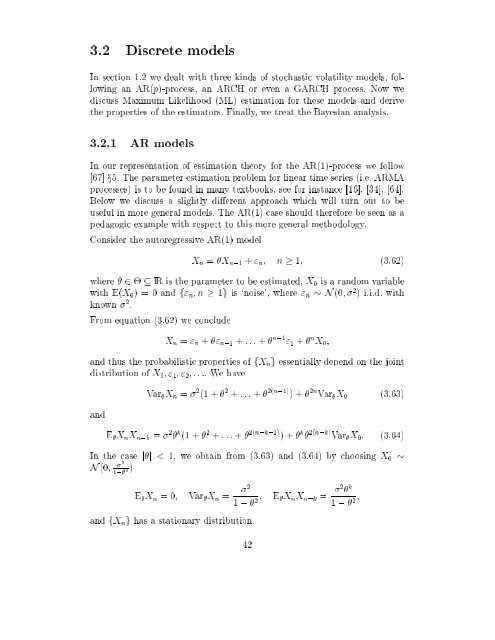Estimation in Financial Models - RiskLab
Estimation in Financial Models - RiskLab
Estimation in Financial Models - RiskLab
You also want an ePaper? Increase the reach of your titles
YUMPU automatically turns print PDFs into web optimized ePapers that Google loves.
3.2 Discrete models<br />
In section 1.2 we dealt with three k<strong>in</strong>ds of stochastic volatility models, follow<strong>in</strong>g<br />
an AR(p)-process, an ARCH or even a GARCH process. Now we<br />
discuss Maximum Likelihood (ML) estimation for these models and derive<br />
the properties of the estimators. F<strong>in</strong>ally, we treat the Bayesian analysis.<br />
3.2.1 AR models<br />
In our representation of estimation theory for the AR(1)-process we follow<br />
[67] x5. The parameter estimation problem for l<strong>in</strong>ear time series (i.e. ARMA<br />
processes) is to be found <strong>in</strong> many textbooks, see for <strong>in</strong>stance [16], [34], [64].<br />
Below we discuss a slightly dierent approach which will turn out to be<br />
useful <strong>in</strong> more general models. The AR(1) case should therefore be seen as a<br />
pedagogic example with respect to this more general methodology.<br />
Consider the autoregressive AR(1) model<br />
X n = X n,1 + " n ; n 1; (3.62)<br />
where 2 IR is the parameter to be estimated, X 0 is a random variable<br />
with E(X 0 ) = 0 and f" n ;n 1g is `noise', where " n N (0; 2 ) i.i.d. with<br />
known 2 .<br />
From equation (3.62) we conclude<br />
X n = " n + " n,1 + :::+ n,1 " 1 + n X 0 ;<br />
and thus the probabilistic properties of fX n g essentially depend on the jo<strong>in</strong>t<br />
distribution of X 0 ;" 1 ;" 2 ;:::.We have<br />
and<br />
Var X n = 2 (1 + 2 + :::+ 2(n,1) )+ 2n Var X 0 (3.63)<br />
E X n X n,k = 2 k (1 + 2 + :::+ 2(n,k,1) )+ k 2(n,k) Var X 0 : (3.64)<br />
In the case jj < 1, we obta<strong>in</strong> from (3.63) and (3.64) by choos<strong>in</strong>g X 0<br />
<br />
N (0; 2<br />
)<br />
1, 2<br />
<br />
E X n =0; Var X n = 2<br />
1 , 2 ; E X n X n,k = 2 k<br />
1 , 2 ;<br />
and fX n g has a stationary distribution.<br />
42
















